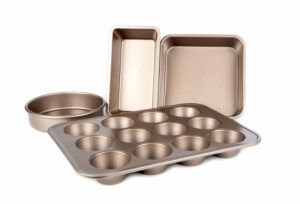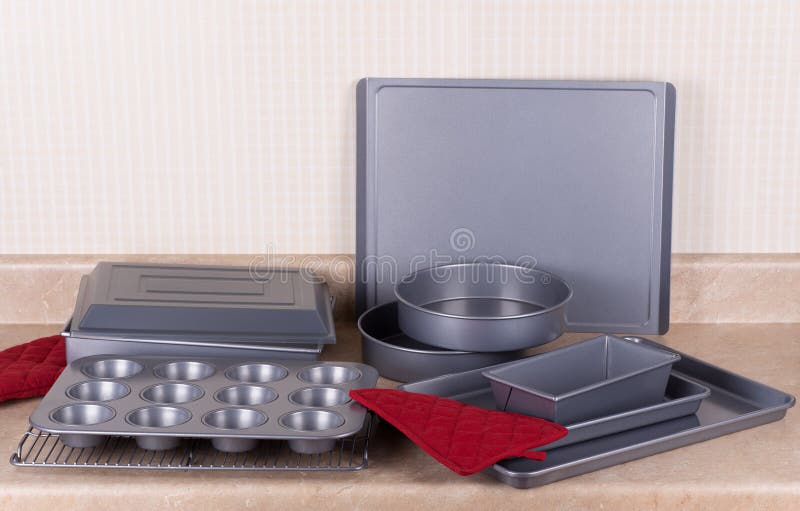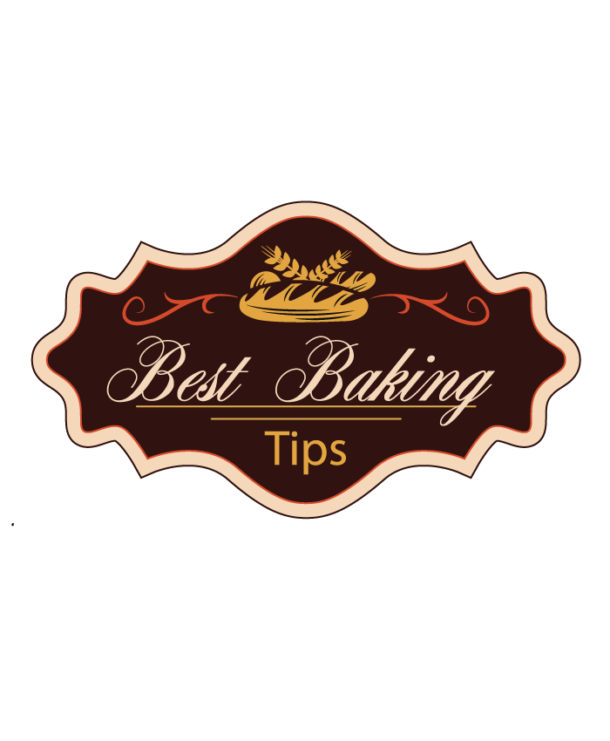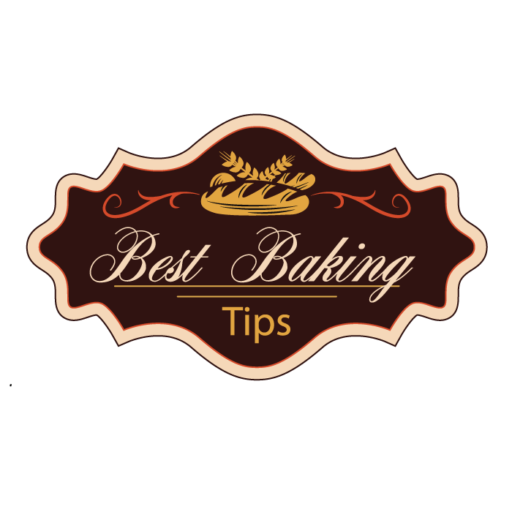==================
Affiliate Statement
Best Baking Tips is supported by our audience. When you purchase through one of our links, we may earn a small affiliate commission. As an Amazon Associate I earn from qualifying purchases. Your cost is not affected.
==================
Which is Better – Glass Bakeware vs. Metal Bakeware
Glass Bakeware vs metal bakeware, which is better? Great tools make for great results. This goes for everything and especially so with food, specifically baking. When baking, you will always want to choose the bakeware that produces the best results. There are numerous baking materials out there, but the most common ones are glass and metal bakeware. In this article, we will be talking about the question, “Which is better – Glass Bakeware vs. Metal Bakeware?”

Glass bakeware (casserole)
What is Glass Bakeware?
To start, let us discuss glass bakeware in this glass bakeware vs. metal bakeware article. Bakeware made of glass is heavier and takes longer to heat than metal bakeware. As a result, it maintains the heat for a considerably more extended period. It is ideal for you to use glass for meals that will be baked at a low temperature for a long time and then kept warm once removed from the oven. In addition, Glass is unaffected by acidic meals.
In general, tempered glass is constructed in ovenproof glass bakeware and is also non-reactive. Being non-reactive means, it does not react to the food it comes into touch with. When you bake in glass, neither elements of glass are released into the meal nor are the food essence absorbed. It is very simple to clean and does not stain. The food browns nicely on glass ovenware, although it takes longer.
Unlike metal, baking pans that brown food more quickly, glass baking dishes makes delicate cakes lighter and more consistent. Because they’re transparent, any browning that does develop is simple to see. These economical pans are dishwasher, microwave, and freezer safe, but they can’t broil.
Pros:
- Glass bakeware is beautiful and highly functional
- It is safe and versatile in use.
- It is easy to clean and dishwasher safe.
- Glass bakeware is microwave safe
- It is non-reactive to acidic foods
- It is non-toxic since there are no chemical coatings in general.
- Glass bakeware responds well to most oven-based cooking.
- Lastly, it is rust and dent-proof.
Cons:
- It’s awful for broiling since the entire pan may shatter.
- You can’t put it on the stove since, again, the entire pan may shatter.
- It is relatively intolerant to quick temperature changes.
- It has uneven heat distribution since glass is a poor heat conductor.
How to Care for Glass Bakeware?
You should clean glass bakeware with hot, soapy water. Soaking in warm water or using a nylon scouring pad may help release stuck-on food. You should avoid metal scrapers and abrasive cleaners. Hold your glassware up to the light after it has been washed; this will allow you to see any remaining residue more clearly.
Something to Remember!
Glass oven bakeware can shatter. Glass bakeware is, of course, relatively safe to use. Simply follow the use and maintenance directions, which vary by brand. The essence of it all is that you should avoid temperature fluctuations. As a result, you can’t move glass bakeware directly from the freezer to the oven or from the oven to the sink. If you want your glass bakeware to endure, you must allow it to cool to room temperature.
What is Metal Bakeware?
Next is the metal bakeware in this glass bakeware vs. metal bakeware article. Metal pans are excellent heat conductors. To put it another way, they become hot fast. However, if removed from the heat source, they cool down more quickly. Also, just because metal bakeware heats up rapidly doesn’t imply it cooks any quicker than glass or ceramic bakeware.
 Metal pans may also tolerate greater temperatures than glass pans. As a result, metal pans are ideal for producing beautiful, uniform browning (particularly with items that won’t be in the oven for extended periods, such as cookies or biscuits). When baked products come out of the range, metal pans are just as handy since you will want to cool them down as soon as possible before consuming them.
Metal pans may also tolerate greater temperatures than glass pans. As a result, metal pans are ideal for producing beautiful, uniform browning (particularly with items that won’t be in the oven for extended periods, such as cookies or biscuits). When baked products come out of the range, metal pans are just as handy since you will want to cool them down as soon as possible before consuming them.
Finally, dull and matte surfaces may speed up the baking process. Shiny pans bake your treats more slowly. It may take considerably longer to bake the same item in a glossy, light-colored baking pan than it would in a shiny, dark pan.
Types of Metal Bakeware
Home kitchens might contain one or more of these three popular types of metal bakeware. In fact, both professional and non-professional bakers often use one of these types for baking. However, to avoid needing to purchase new ones frequently, each needs a particular kind of maintenance.
-
Stainless Steel
Stainless steel provides a durable and high-quality material for bakeware. It provides an excellent base since it heats up fast and evenly. With stainless steel, you won’t need a non-stick coating. However, using stainless steel bakeware often results in a crusty, stuck-on mess without proper maintenance.
Stainless steel is a durable and safe metal that is utilized in many commercial culinary applications. However, due to its low heat conductivity, its usage in bakeware is restricted to sheet pans and pie pans.
-
Aluminum
Aluminum is a great baking material because it conducts heat well, resulting in uniform baking. However, you should be aware that the glossy surface of the aluminum may hinder proper browning. Aluminum bakeware is also rust-resistant and long-lasting.
Cakes, bars, and pies benefit from aluminum and also focaccia, sandwich loaves, and rolls. The metal warms up more quickly than glass, resulting in a higher rise and sharper, browner edges.
Consider the cautions, however, when using aluminum. Indeed, many people refuse to use aluminum due to the potential health risks. The NCBI provides additional information on the Health Effects of Aluminum Exposure.
-
Carbon Steel
Carbon steel offers an attractive option for non-toxic, environmentally friendly cookware. You might wonder, “what is carbon steel?” In fact, this strong material of a blend of iron and carbon offers great safety for use in the kitchen. When carbon steel is heated, it contains no coating and does not leach any chemicals. Simply said, carbon steel is lighter, less clumsy relative to cast iron. Many home kitchens host carbon steel bakeware and cookware.
Carbon steel, a more robust and more durable choice than aluminum, stands up to repeated use in many restaurant kitchens, too. Carbon steel cookware is just as safe for baking as it is for other types of cooking. A well-seasoned carbon steel pan may be used for baking since it has a non-stick surface. Casseroles, cakes, bread, pies, and other sweets work well in carbon steel baking pans.
Pros:
- Metal bakeware is very durable and sturdy.
- It is thinner and much lighter glassware.
- It is also generally cheaper than glass bakeware.
- Metal bakeware is better at conducting heat than glass is.
- It is suitable for dishes you’d like to brown.
- It can withstand very high temperatures as well as drastic temperature changes.
- Metal bakeware is also easy to clean and care for.
Cons:
- Metal bakeware doesn’t go well with acidic foods
- Cheap metal bakeware can even make food taste a little metallic.
- It is not naturally non-stick.
- It cools off very quickly.
How to Care for Metal Bakeware?
To eliminate any residues of oils from stainless steel metal bakeware, wash it in warm, soapy water with 1/4 cup vinegar. Then you should rinse it well and pat it dry with a soft towel. To condition non-stick coatings or new specific non-stick metals, use 1 tsp (5 ml) vegetable oil before using it for the first time. Using a soft cloth, carefully rub the oil over the inside. If food starts to cling to the pan, repeat the conditioning procedure every 2 to 3 months.
Additional Tip!
Non-stick sprays should not be used on non-stick cookware. They create an unnoticeable accumulation of grime over time that affects the non-stick release mechanism, allowing food to cling to the non-stick pan.
When to Use Glass Bakeware?
Glass baking pans are very popular for casseroles since they can travel from the oven to the dinner table and hold the oven’s heat for longer, keeping the food warm. Baked meat meals, baked pasta, bread puddings, pies, cobblers, and crisps and crumbles are among the other foods available. It goes well with roasted meats and lasagna.
When to use Metal Bakeware?
When baking cookies, brownies, cookie bars, muffins, scones, biscuits, rolls, cakes, and quick bread, you’ll want to use a metal pan more frequently than not. You can also make savory dishes like meatloaf.
Which is better – Glass Bakeware vs. Metal Bakeware?
Now that we know the differences between glass bakeware vs. metal bakeware, we can have a better answer or idea regarding the earlier question, “Which is better – Glass Bakeware vs. Metal Bakeware. ” To be honest, I do not think it can be answered by a definitive yes or no. Both have their pros and cons, advantages and disadvantages.
Personally, though, if it comes to baking in general, then metal bakeware would win. There is a reason why most professional chefs use metal bakeware. However, that does not mean that glass bakeware is not used in professional bakeries.
At the end of the day, my preference should not influence you as much. I have and will always think that people know themselves best. No matter how much I try to sell or convince you regarding metal bakeware, in the end, it will be your choice that will affect you. My advice would be that you choose the one you think you prefer and is perfect for what you plan to do. So for you, glass bakeware vs metal bakeware – which is better?
Read More:
BakeWare Facts (anchorhocking)
Is It Safe to Use Aluminum Foil in Cooking?(Healthline)






